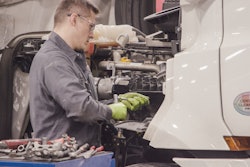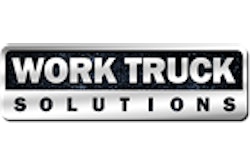
Last year won’t go down as a record-setter for most aftermarket businesses. But after the transcendent heights of 2022, the slow decline most operations experienced in 2023 could have been a lot worse.
Parts demand dipped — but didn’t crater — and after nearly two years of extreme availability and pricing volatility, the supply chain finally reset from the multi-year disruption created by the pandemic.
Economic sentiment for 2024 is mostly muted both within and outside the aftermarket, but after preparing last spring for a 2023 recession that never came, many aftermarket operations believe they are prepared to withstand whatever is thrown at them in the year ahead.
[Download our state of the industry survey results!]
In speaking with and surveying aftermarket executives in late 2023, Trucks, Parts, Service found while most people in the industry aren’t exactly optimistic about 2024, they finally know what they’re up against.
“I think we’re finally resetting the market a little bit back to what we’re used to,” said Michael Callison Jr., president at Midwest Wheel Companies and co-chair of next week’s Heavy Duty Aftermarket Week (HDAW). “During COVID, everybody went up [with prices] so fast it was hard to get a read on everything that was happening. That’s finally ended.”
He added, “business has softened a bit, but everything [pricing, demand] seems more solid. Easier to understand and predict.”
2023 sees higher sales, lower margins
Sentiment around 2023 was mostly a mixed bag as the year closed.
Sales totals were generally higher — 56% of aftermarket responders to a fall 2023 TPS survey of dealer, aftermarket and supplier readers reported their businesses were up at least 2% year over year with another 17% of responders’ operations in line with 2022 — though reasons for that growth varied.
Aftermarket parts demand has been contracting for months, and Total Truck Parts President Marc Karon believes the price inflation that hit the aftermarket in 2021 and extended into 2023 created sales totals that did not necessarily reflect the strength of markets in which they were earned.
“Sales are definitely up, but they’re not truly indicative of gross profits,” he said in November.
Additionally, as prices normalized throughout last year, margins were squeezed. Karon believes the worst of that is behind the industry, but adds presuming 2023 was a good year because top-line revenues increased would be erroneous.
Other distributors agreed. Bill Nolan, president at PBS Truck Parts, said in November his business was tracking to finish “up this year but flat compared to 2022 after we adjust for inflation.” Callison said Midwest Wheel attributed price to be a substantive component of its year-over-year sales gains.
“In 2022, for every quarter our fixed [operations] never had a slowdown,” added Momentum Truck Group President Jon Pearson in November. “This year, we actually started a little slow. Business has picked up, but it isn’t going to be what 2022 was.”
Those assessments track with MacKay & Company’s market analysis, too. John Blodgett, vice president of sales and marketing, said in November MacKay & Company was predicting aftermarket sales to be up nearly 4% in 2023 — but mostly due to price inflation.
“It’s basically flat compared to last year [2022],” he said. “If you look top line we’re about 3.9%, but we have price up about 3.5%.”
Yet 2023 wasn’t all bad for the aftermarket. The industry did have bright spots. Expansion was one path to profitability, and service continued to offer a buffer against the margin degradation occurring in the parts segment as the year progressed.
At Midwest Wheel, Callison says the company’s continued expansion in Missouri outpaced same-store sales for some of its more established locations and the company expects “pretty heavy growth” for its new facilities into 2024 and beyond.
[RELATED: MacKay & Company shares its 2023 insights, early 2024 predictions]
In Kansas City, Custom Truck One Source leveraged its overwhelming inventory size to earn new customers when the supply chain was most fragile in 2021 and 2022, and Director of Central Retail Parts Mike Richards says those new customers continued to pay dividends in 2023.
“At the height [of the parts shortage] when everyone was scrambling for parts we were selling to new customers and competitors,” he says. “We were able to earn business then that we’ve kept on.”
Other aftermarket operations also expanded to fortify their operations in 2023.
Nearly half of TPS aftermarket survey responders (44%) added to their workforces last year while 26% expanded their facilities. Another 35% considering doing the same. Product offerings were also on the rise, with 61% of distributors adding lines last year and only 9% contracting.
That diversification enabled distributors and service providers to acquire new business to sustain healthy sales while parts demand stagnated.
Service was another winning market segment.
“Our drive-in service has been our strongest division by far,” said Nolan. “We perform specialty services like heavy-duty suspension work and we always have. Many of our competitors cannot get their people to perform that type of work. So, we pick up a lot of the work others cannot perform.”
“The shops were the one area of the business that excelled,” added Karon. “Demand for repair services keeps increasing as trucks become more complicated and fleets are unwilling to pay the high salaries of technicians. Although demand continues to increase, capacity in the market is not increasing.”
TPS’ survey confirms this capacity problem. While 76% of TPS aftermarket responders report the average age of their customers’ equipment is at least seven years old, only 11% of responders say more than half of their annual sales revenues comes from service. Nearly three in 10 responders (28%) say they don’t have service revenues at all.
And businesses that do have service bays are working tirelessly to expand them. Adding technicians was the top problem for 20% of TPS aftermarket survey responders in 2023 — second only to business and economic conditions such as inflation.
Cody Brooks opened Brooks Diesel Service as a mobile service and parts sales business in 2017 and expanded with a shop in 2018. Brooks said in November his parts and service operations both continue to grow and set annual records for the young business, but service offers greater profitability leaps because there’s so much work in the market to be earned.
“I figure any other technician I could hire we could immediately keep busy,” he said. “It’s all about getting staff and keeping them here so we can grow organically.”
Aftermarket looks for growth in 2024
Growth opportunities this year will likely mirror what worked in 2023, believe most across the aftermarket.
Blodgett said MacKay & Company’s 2024 forecast as of November had the aftermarket expanding by 3.1% this year, with 1.5% of that growth coming due to price inflation. The latter is more in line with historic norms for the first time since the pandemic.
Blodgett also reported MacKay & Company believes the year will start on the softer end and pick up momentum as the months progress — sentiment equaled by other trucking data firms and industry economists. MacKay & Company will provide more details into its forecast and the recession potential of the economy during Heavy Duty Aftermarket Dialogue on Monday.
Among fall 2023 TPS survey responders, recessionary fears may exist but do not appear to be driving overly conservative industry projections.
Nearly 70% of aftermarket responders stated they anticipate 2024 to be equal (22%) or slightly higher (48%) than 2023 for overall aftermarket sales. Among those same responders, 48% also have sales goals to slightly exceed last year, while 15% are shooting for sales to be equivalent to last year. On the latter note, there is more optimism than pessimism, as 26% of responders have sales goals at least 10% higher than last year while only 11% shifted sales goals downward year over year.
Wrote one responder, “We always plan to grow, improve and learn, so that fuels optimism that we will be able to have a positive improvement going forward in some areas if not all.”
Another stated the “recent addition of new customers and overall business climate in our market area” as a reason for optimism.
Richards is equally bullish about his business, stating its area of operation around Kansas City has outpaced industry growth averages for years. Though Custom Truck did see some order softening during the second half of 2023, Richards said the business remained up year over year and on track to continue expansion into 2024.
“We don’t allow for excuses. We’re always looking to grow,” he said. “One thing we will do if business shifts, we will look to see if we need to pivot our inventory or where our focus is.”
Brooks has a similarly hopeful outlook in Oklahoma. He doesn’t expect 2024 to replicate the huge gains his company earned 2021-2023, but he does believe it is positioned to expand its relationships with existing customers to grow. To conquest new business will require more labor — which Brooks still hopes to add — but barring a complete market tumble, he believes his company will post another positive year.
Yet challenges unquestionably exist.
Karon said price deflation from vendors on products that were overly inflated during the supply chain crunch will still impact margins in the early months of the year. And while U.S. GDP rose substantially in Q3, truck tonnage did not do the same. Freight rates and volumes are expected to begin climbing again in 2024, but until they do, the aftermarket may simply tread water.
“Normally a recession hits you in payments,” he said. “Customers needing an extra 30 days to make payments, missing payments they normally make … . We will be watching that carefully into the new year.”
The presidential election is another uncertainty. Business investment often slows in the months leading up to an election. Among TPS survey responders, 18% state the political climate in Washington, D.C., as their top business concern, with another 7% ranking it second and 20% ranking it third.
Callison said Midwest Wheel accounts for an election dip in its annual projections but admitted it’s hard to know exactly what to estimate.
Industry competition isn’t going away either. The parts and service business only continues to become more contested. Aftermarket executives say 2024 will again be a year where customer service excellence translated to growth opportunities for businesses.
“Our crystal ball is very cloudy. It could be good. It could be bad,” said Nolan. “We just need to focus on doing everything in our power to take care of our customers and let the chips fall where they may.”
“I think this will be a year where we have to watch our expenses and make sure we have our ducks in a row,” added Pearson. “We will need to keep our fulfillment rates, billable hours and labor rates in the zones where they need to be for us to be successful.
“We will need to stay in good communication with our customers too. We need to be on the front side with them, talking about their business and what their challenges are.”
This is Part 2 of Trucks, Parts, Service's three-part industry status report entering 2024. Part I focused on the dealer channel and Part 3 addresses the supplier community.











